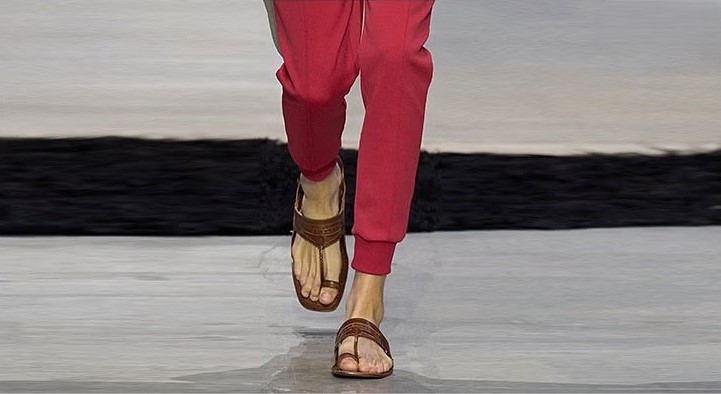Background: The Kolhapuri Controversy
The controversy erupted shortly after Prada’s Spring-Summer 2026 Men’s collection debuted at Milan Fashion Week, where the luxury label showcased a series of leather sandals that bore a striking resemblance to Kolhapuri chappals—traditional handcrafted footwear from India, recognised under the country’s Geographical Indication (GI) tag. Despite their visual and structural similarity to this heritage Indian product, Prada’s show notes made no reference to Kolhapuris or their cultural significance.
This omission drew swift backlash from Indian artisan groups and cultural stakeholders, with the Maharashtra Chamber of Commerce, Industry and Agriculture (MACCIA) formally raising concerns. They accused the brand of cultural appropriation and failing to acknowledge the legacy of the Kolhapuri craft, which supports thousands of artisans in Maharashtra and Karnataka. MACCIA also alerted central and state authorities, flagging the lack of attribution and the potential infringement of GI rights.
Prada Responds to MACCIA Over Kolhapuri-Inspired Sandals, Pledges Dialogue with Indian Artisans
Italian luxury fashion brand Prada has formally addressed rising concerns over its Kolhapuri-style sandals featured in the Spring-Summer 2026 Men’s collection, following a written complaint by the Maharashtra Chamber of Commerce, Industry and Agriculture (MACCIA). The footwear, which closely resembles India’s iconic Kolhapuri chappals—a product with Geographical Indication (GI) status—sparked backlash for the lack of attribution to its cultural and artisanal roots.
In a letter sent to MACCIA, Lorenzo Bertelli, Prada’s Head of Corporate Social Responsibility and son of Group Co-Founders Miuccia Prada and Patrizio Bertelli, acknowledged the inspiration behind the design, stating: “We acknowledge that the sandals featured in the recent Prada Men's 2026 Fashion Show are inspired by traditional Indian handcrafted footwear, with a centuries-old heritage.”
Bertelli further clarified that the design is still under development and may not be commercialised, hinting at the possibility of changes or reconsideration. The brand also expressed openness to a dialogue with Indian artisans and suggested the potential for follow-up meetings aimed at engaging in a "meaningful exchange."
This public clarification follows MACCIA’s appeal to both central and state government authorities, urging them to investigate what it described as potential misappropriation of India’s artisanal legacy. The Chamber emphasised that Kolhapuri chappals, with their GI protection, are not merely stylistic products but represent a living tradition involving thousands of skilled craftspeople from Maharashtra and Karnataka.
A Prada spokesperson independently confirmed the brand's respect for cultural origins and design legacies, stating: “Prada has always celebrated craftsmanship, heritage, and design traditions.”
A Broader Conversation on Cultural Sensitivity in Luxury Fashion
Prada’s statement comes at a time when global luxury houses are increasingly being scrutinised for cultural borrowing, often without tangible benefit or recognition to source communities. In this case, Kolhapuri chappals—originating in the 13th century and handcrafted by generations of cobblers using vegetable-tanned leather and intricate braiding techniques—represent more than a design silhouette; they embody an ecosystem of heritage, economy, and identity.
While this is not the first instance of a global fashion house being called out for appropriation, what makes this case significant is the formal recognition of MACCIA as a legitimate stakeholder and the rare openness by Prada to explore future engagement with artisan communities. This moment signals a shift—from mere acknowledgement to potential collaboration.
The situation also underscores the urgency for stronger frameworks within the fashion industry for recognising GI-tagged crafts internationally. While India’s domestic GI registry offers certain protections, global enforcement and awareness remain limited.
The Path Forward
MACCIA has welcomed Prada’s response and indicated willingness to engage in dialogue. However, it also emphasised that future collaborations must ensure fair credit, economic benefit, and long-term visibility for Indian artisans. Stakeholders are now watching closely to see if the brand will extend support through formal collaborations, design acknowledgements, or even economic participation via licensing or partnerships.
As Indian design traditions gain traction in global fashion narratives, this episode serves as a reminder that heritage is not just a muse—it is a responsibility.











